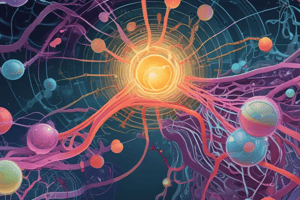Podcast
Questions and Answers
What is the primary role of oxygen in photosynthesis?
What is the primary role of oxygen in photosynthesis?
- Oxygen is absorbed during glycolysis.
- Oxygen is produced during the Krebs cycle.
- Oxygen results from the splitting of water molecules. (correct)
- Oxygen helps regenerate chlorophyll.
Which sequence correctly outlines the stages of aerobic respiration?
Which sequence correctly outlines the stages of aerobic respiration?
- Electron Transport Chain → Glycolysis → Krebs Cycle
- Glycolysis → Electron Transport Chain → Krebs Cycle
- Glycolysis → Krebs Cycle → Electron Transport Chain (correct)
- Krebs Cycle → Glycolysis → Electron Transport Chain
What is the major difference between aerobic and anaerobic respiration?
What is the major difference between aerobic and anaerobic respiration?
- Anaerobic respiration utilizes oxygen, while aerobic respiration does not.
- Aerobic respiration results in water production, while anaerobic does not. (correct)
- Anaerobic respiration produces more ATP than aerobic respiration.
- Aerobic respiration occurs only in eukaryotes.
How many ATP are produced during glycolysis?
How many ATP are produced during glycolysis?
What is the final electron acceptor in the electron transport chain during aerobic respiration?
What is the final electron acceptor in the electron transport chain during aerobic respiration?
What is the main process involved in the creation of ATP from ADP?
What is the main process involved in the creation of ATP from ADP?
Which of the following describes ATP's role in cellular processes?
Which of the following describes ATP's role in cellular processes?
During photosynthesis, which wavelengths of light does chlorophyll primarily absorb?
During photosynthesis, which wavelengths of light does chlorophyll primarily absorb?
What distinguishes active transport from passive transport?
What distinguishes active transport from passive transport?
Where does the Calvin cycle take place during photosynthesis?
Where does the Calvin cycle take place during photosynthesis?
Which of the following statements about ATP is incorrect?
Which of the following statements about ATP is incorrect?
Which reaction represents the overall process of photosynthesis?
Which reaction represents the overall process of photosynthesis?
What is the role of ATP in active transport?
What is the role of ATP in active transport?
Flashcards are hidden until you start studying
Study Notes
ATP Creation
- ATP is created from ADP (Adenosine Diphosphate) through phosphorylation, adding a phosphate to ADP
- This process requires energy input, making it an endergonic reaction
- ATP Synthase is the enzyme responsible for synthesizing ATP
- ATP is a very reactive molecule that releases energy quickly, making it ideal for immediate use
- ATP's structure has negatively charged phosphates that repel each other, storing potential energy
Cellular Use Of ATP
- ATP is the primary energy carrier in cells, powering essential processes
- It is vital for the cell cycle, including cell division and overall metabolism
- ATP is used to build polymers from monomers
- It is required for muscle contractions and powering movement
- Active transport of molecules against their concentration gradients requires ATP
- ATP also plays a role in cellular signaling pathways
Passive vs. Active Transport
- Passive Transport does not require energy input; molecules move from areas of high concentration to low concentration
- Simple Diffusion: Molecules move freely across a membrane without assistance
- Facilitated Diffusion: Larger molecules or hydrophilic molecules require transport proteins to move across the membrane
- Active Transport requires energy to move molecules against their concentration gradient, often using transport proteins
Photosynthesis
- Occurs in chloroplasts, which contain two key compartments:
- Thylakoids: Contain light-absorbing pigments and are the site of light-dependent reactions
- Stroma: The aqueous space where the Calvin cycle (light-independent phase) takes place, synthesizing sugars
- Light-Dependent Reactions require sunlight and occur in the thylakoids, producing ATP and NADPH
- Calvin Cycle does not require sunlight and utilizes ATP and NADPH to convert carbon dioxide into glucose in the stroma
- The overall reaction is: 6 CO2 + 6 H2O + light energy → C6H12O6 + 6 O2
- Oxygen is released during the splitting of water molecules within the thylakoid membrane to replace energized electrons used in chlorophyll
- Chlorophyll absorbs most wavelengths except green, which is reflected, giving plants their green color
Cellular Respiration
- Aerobic Respiration uses oxygen to produce ATP
- Begins with Glycolysis, which occurs in the cytoplasm, producing pyruvate and a small amount of ATP (2 ATP), along with NADH
- The pyruvate from glycolysis enters the Krebs Cycle, also known as the citric acid cycle, which takes place in the mitochondria, producing more ATP (2 ATP), NADH, and FADH2
- The final stage is the Electron Transport Chain, also in the mitochondria, which utilizes NADH and FADH2 to produce the majority of ATP (up to 34 ATP)
- During the Electron Transport Chain, energized electrons pass through a series of proteins, creating a proton gradient that is used to drive ATP synthesis
- Oxygen acts as the final electron acceptor, forming water
- Anaerobic Respiration does not use oxygen and produces less ATP (only 2 ATP)
- Common in bacteria and some eukaryotes (e.g., yeast)
- Fermentation is a type of anaerobic respiration that produces energy in the absence of oxygen
- Alcoholic Fermentation: Produces ethanol (alcohol) and carbon dioxide, commonly done by yeast
- Lactic Acid Fermentation: Produces lactic acid, occurs in human muscle cells when oxygen supply is limited, leading to muscle fatigue
Studying That Suits You
Use AI to generate personalized quizzes and flashcards to suit your learning preferences.




